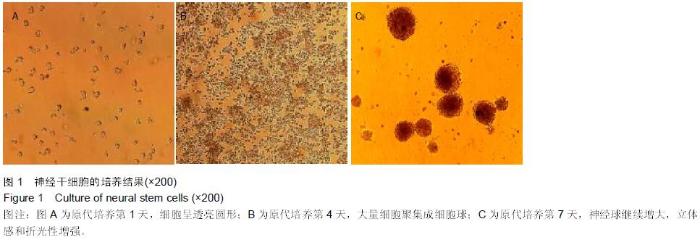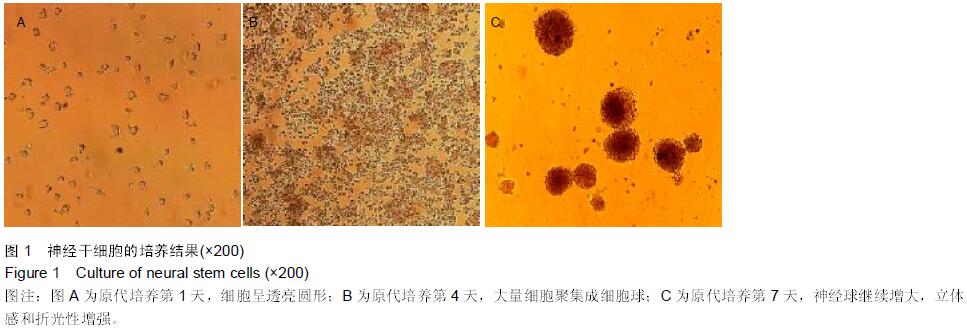Chinese Journal of Tissue Engineering Research ›› 2015, Vol. 19 ›› Issue (45): 7314-7319.doi: 10.3969/j.issn.2095-4344.2015.45.018
Previous Articles Next Articles
Neural stem cell transplantation for partial sciatic nerve transaction-induced neuropathic pain: the optimal cell number for transplantation
Deng Mo1, Zhao Feng2
- 1Department of Anesthesiology, 2Department of Interventional Radiology, Affiliated Hospital of Hebei University, Baoding 071000, Hebei Province, China
-
Received:2015-09-28Online:2015-11-05Published:2015-11-05 -
Contact:Zhao Feng, Master, Attending physician, Department of Interventional Radiology, Affiliated Hospital of Hebei University, Baoding 071000, Hebei Province, China -
About author:Deng Mo, Master, Attending physician, Department of Anesthesiology, Affiliated Hospital of Hebei University, Baoding 071000, Hebei Province, China -
Supported by:the Medical Science Research Project of Hebei Province, No. 20110515
Cite this article
Deng Mo, Zhao Feng. Neural stem cell transplantation for partial sciatic nerve transaction-induced neuropathic pain: the optimal cell number for transplantation[J]. Chinese Journal of Tissue Engineering Research, 2015, 19(45): 7314-7319.
share this article
|
[1] Coleman MP, Freeman MR. Wallerian degeneration, wld(s), and Nmnat. Ann Rev Neurosci. 2010;33:245-267.
[2] Zheng L, Cui HF. Enhancement of nerve regeneration along a chitosan conduit combinedwith bone marrow mesenchymal stem cells. J Mater Sci Mater Med. 2012;23(9):2291-2302.
[3] Okawa T, Kamiya H, Himeno T, et al. Transplantation of neural crest like cells derived from induced pluripotent stem cells improves diabetic polyneuropathy in mice. Cell Transplantation. 2012.
[4] Xu L, Zhou S, Feng GY, et al.Neural stem cells enhance nerve regeneration after sciatic nerve injury in rats. Mol Neurobiol. 2012;46(2):265-274.
[5] Kato N, Matsumoto M, Kogawa M, et al. Critical role of p38 MAPK for regeneration of the sciatic nerve following crush injury in vivo. J Neuroinflammation. 2013;10:1.
[6] Cao X, Zhao P, Tao Q, et al. The role ofC-terminal binding protein 2 in Schwann cell differentiation after sciatic nerve crush. J Mol Neurosci. 2013;49(3):531-538.
[7] Aigner A. Delivery systems for the direct application of siRNAs to induce RNA interference (RNAi) in vivo. J Biomed Biotechnol. 2006;2006:1-15.
[8] Viana F, Dela peña E, Belmonte C. Specificity of cold thermotransduction is determined by differential ionic channel expression. Nat Neurosci. 2002;5(3):254-260.
[9] Linden AM, Sandu C, Aller MI, et al. TASK-3 knockout mice exhibit exaggerated nocturnal activity, impairments in cognitive functions, and reduced sensitivity to inhalation anesthetics. J Pharmacol Exp Ther. 2007;323(3):924-934.
[10] Pitcher GM, Henry JL. Governing role of primary afferent drive in increased excitation of spinal nociceptive neurons in a model of sciatic neuropathy. Exp Neurol. 2008;214(2): 219-228.
[11] Khan GM, Chen SR, Pan HL. Role of primary afferent nerves in allodynia caused by diabetic neuropathy in rats. Neuroscience. 2002;114(2):291-299.
[12] Han HC, Lee DH, Chung JM. Characteristics of ectopic discharges in a rat neuropathic pain model. Pain. 2000;84: 253-262.
[13] Baron R. Neuropathic pain. The long path from mechanisms to mechanism-based treatment. Anaesthesist. 2000;49(5): 373-386.
[14] Baron R. Peripheral neuropathic pain: from mechanisms to symptoms. Clin J Pain. 2000;16(2 Suppl):S12-S20.
[15] Devor M. Ectopic discharge in Aβ afferents as a source of neuropathic pain. Exp Brain Res. 2009;196(1):115-128.
[16] Sandkuhler J. Undersanding LTP in pain pathways. Mol Pain. 2007;3:9.
[17] Adler JE, Nico I, Vande Vord P, et al.Modulation of neuropathic pain by a glial derived factor.Pain Med. 2009; 10(7):1229-1236.
[18] Han M, Huang RY, Du YM, et al. Early intervention of ERK activation in the spinal cord can block initiation of peripheral nerve injury-induced neuropathic pain in rats. Acta Physiologica Sinica. 2011;63(2):106-114.
[19] Zhang Z, Zhang ZY, Fauser U, et al. Mechanical allodynia and spinal up-regulation of P2X4 receptor in experinental auto immune neuritis rats. Neuroscience. 2008;152(2):495-501.
[20] 刘峰,袁贤瑞.白血病抑制因子在周围神经损伤修复中的应用[J].国际神经病学神经外科杂志,2005,32(5):442-444.
[21] Moalem-Taylor G, Li M, Allbutt HN, et al. A preconditioning nerve lesion inhibits mechanical pain hypersensitivity following subsequent neuropathic injury. Pain. 2011;7(5):1-9.
[22] 万有,刘风雨.急性疼痛早期治疗的必要性[J].中国疼痛医学杂志, 2011,17(1):1-5.
[23] Casula MA, Facer P, Powell AJ, et al. Expression of the sodium channel [beta] 3 subunit in injured human sensory neurons. Neuroreport. 2004;15(10):1629-1632.
[24] Groebner M,David R,Franz WM.Embryonic stem cells. Internist (Berl). 2006;47(5):502–508.
[25] McKay R. Stem cells in the central nervous system. Science. 1997;276 (5309):66-71.
[26] Mothe AJ, Bozkurt G, Catapano J, et al. Intrathecal transplantation of stem cells by lumbar puncture for thoracic spinal cord injury in the rat. Spinal Cord. 2011;49(9):967-973.
[27] Rao MS, Mattson MP. Stem cells and aging:expanding the possibilities. Mech Ageing Dev. 2001;122(7):713-734.
[28] Ghosh M, Tuesta LM, Puentes R, et al. Extensive cell migration, axon regeneration,and improved function with polysialic acid-modified Schwann cells after spinal cord injury. Glia. 2012;60(6):979-992 .
[29] Chen W, Xu ZM, Wang G, et al. Non-motor symptoms of Parkinson, s disease in china: a review of the literature. Parkinsonism Relat Disord. 2012;18(5):446-452.
[30] 韩志桐,苏宁,吴日乐,等.GFP转基因小鼠神经干细胞移植治疗大鼠帕金森病的实验研究[J].临床神经外科杂志,2012,9(3):139- 142.
[31] 陈涛,田增民,尹丰,等.神经干细胞移植治疗帕金森病的临床研究[J].中国微侵袭神经外科杂志,2012,17(10):452-453.
[32] 包晓群,宋亚彬,李松涛,等.神经干细胞移植治疗帕金森病[J].中国老年学杂志,2013,33(8):3591-3592.
[33] Fattore C, Perucca E. Novel medications for epilepsy. Drugs. 2011;71(16):2151-2178.
[34] Berg AT, Scheffer IE. New concepts in classification of the epilepsies: entering the 21st century. Epilepsia. 2011;52(6): 1058-1062.
[35] Kvalsund MP, Birbeck GL. Epilepsy care challenges in developing countries. Curr Opin Neurol. 2012;25(2):179-186.
[36] Zhao Y, Wu H, Wang X, et al. Clinical epidermiology of posttraumatic epilepsy in a group of Chinese patients. Seizure. 2012;21(5):322-326.
[37] 张化明,杨海,马江红,等.神经干细胞移植并手术治疗重型颅脑损伤的疗效分析[J].中国实用神经疾病杂志,2013,16(13):52-53.
[38] Lu P, Wang Y, Graham L, et al. Long-distance growth and connectivity of neural stem cells after severe spinal cord injury. Cell. 2012;150:1264-1273.
[39] 娄永利.神经干细胞移植治疗脊髓损伤的临床研究[J].中外医疗, 2012,31(2):22. |
| [1] | Lin Qingfan, Xie Yixin, Chen Wanqing, Ye Zhenzhong, Chen Youfang. Human placenta-derived mesenchymal stem cell conditioned medium can upregulate BeWo cell viability and zonula occludens expression under hypoxia [J]. Chinese Journal of Tissue Engineering Research, 2021, 25(在线): 4970-4975. |
| [2] | Pu Rui, Chen Ziyang, Yuan Lingyan. Characteristics and effects of exosomes from different cell sources in cardioprotection [J]. Chinese Journal of Tissue Engineering Research, 2021, 25(在线): 1-. |
| [3] | Zhang Tongtong, Wang Zhonghua, Wen Jie, Song Yuxin, Liu Lin. Application of three-dimensional printing model in surgical resection and reconstruction of cervical tumor [J]. Chinese Journal of Tissue Engineering Research, 2021, 25(9): 1335-1339. |
| [4] | Li Dadi, Zhu Liang, Zheng Li, Zhao Fengchao. Correlation of total knee arthroplasty efficacy with satisfaction and personality characteristics [J]. Chinese Journal of Tissue Engineering Research, 2021, 25(9): 1346-1350. |
| [5] | Wei Wei, Li Jian, Huang Linhai, Lan Mindong, Lu Xianwei, Huang Shaodong. Factors affecting fall fear in the first movement of elderly patients after total knee or hip arthroplasty [J]. Chinese Journal of Tissue Engineering Research, 2021, 25(9): 1351-1355. |
| [6] | Lü Zhen, Bai Jinzhu. A prospective study on the application of staged lumbar motion chain rehabilitation based on McKenzie’s technique after lumbar percutaneous transforaminal endoscopic discectomy [J]. Chinese Journal of Tissue Engineering Research, 2021, 25(9): 1398-1403. |
| [7] | Huang Dengcheng, Wang Zhike, Cao Xuewei. Comparison of the short-term efficacy of extracorporeal shock wave therapy for middle-aged and elderly knee osteoarthritis: a meta-analysis [J]. Chinese Journal of Tissue Engineering Research, 2021, 25(9): 1471-1476. |
| [8] | Gao Yan, Zhao Licong, Zhao Hongzeng, Zhu Yuanyuan, Li Jie, Sang Deen. Alteration of low frequency fluctuation amplitude at brain-resting state in patients with chronic discogenic low back pain [J]. Chinese Journal of Tissue Engineering Research, 2021, 25(8): 1160-1165. |
| [9] | Zhang Xiumei, Zhai Yunkai, Zhao Jie, Zhao Meng. Research hotspots of organoid models in recent 10 years: a search in domestic and foreign databases [J]. Chinese Journal of Tissue Engineering Research, 2021, 25(8): 1249-1255. |
| [10] | Wang Zhengdong, Huang Na, Chen Jingxian, Zheng Zuobing, Hu Xinyu, Li Mei, Su Xiao, Su Xuesen, Yan Nan. Inhibitory effects of sodium butyrate on microglial activation and expression of inflammatory factors induced by fluorosis [J]. Chinese Journal of Tissue Engineering Research, 2021, 25(7): 1075-1080. |
| [11] | Wang Xianyao, Guan Yalin, Liu Zhongshan. Strategies for improving the therapeutic efficacy of mesenchymal stem cells in the treatment of nonhealing wounds [J]. Chinese Journal of Tissue Engineering Research, 2021, 25(7): 1081-1087. |
| [12] | Liao Chengcheng, An Jiaxing, Tan Zhangxue, Wang Qian, Liu Jianguo. Therapeutic target and application prospects of oral squamous cell carcinoma stem cells [J]. Chinese Journal of Tissue Engineering Research, 2021, 25(7): 1096-1103. |
| [13] | Xie Wenjia, Xia Tianjiao, Zhou Qingyun, Liu Yujia, Gu Xiaoping. Role of microglia-mediated neuronal injury in neurodegenerative diseases [J]. Chinese Journal of Tissue Engineering Research, 2021, 25(7): 1109-1115. |
| [14] | Li Shanshan, Guo Xiaoxiao, You Ran, Yang Xiufen, Zhao Lu, Chen Xi, Wang Yanling. Photoreceptor cell replacement therapy for retinal degeneration diseases [J]. Chinese Journal of Tissue Engineering Research, 2021, 25(7): 1116-1121. |
| [15] | Jiao Hui, Zhang Yining, Song Yuqing, Lin Yu, Wang Xiuli. Advances in research and application of breast cancer organoids [J]. Chinese Journal of Tissue Engineering Research, 2021, 25(7): 1122-1128. |
| Viewed | ||||||
|
Full text |
|
|||||
|
Abstract |
|
|||||









